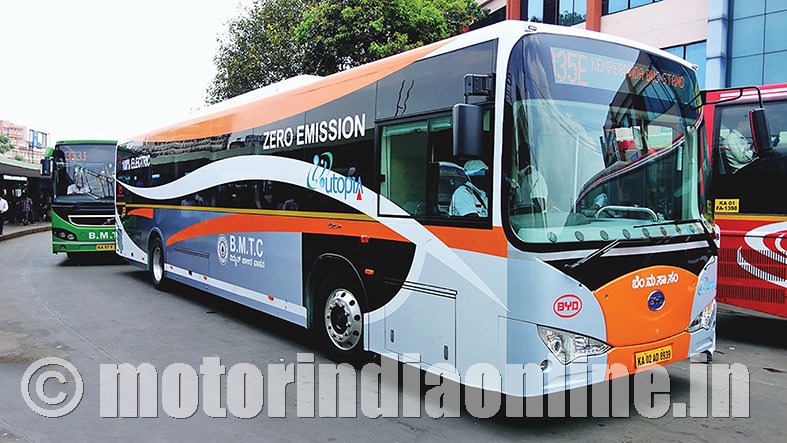Mr. H.K. Agarwal of Sympar Associates, Delhi, a veteran electrical technology expert, is seeking platforms where an operational model of low-cost electric buses powered by lead acid batteries can be built for commercial emulation.

Electric buses are the serious talk of the ‘auto’ town these days. So, it may appear as if the era of silent, zero-emission urban transport is finally here. But is it? Any such claims actually amount to stretching the truth somewhat, perhaps, by over a century! The history of electric buses is as old as the history of buses itself, that the application of electric propulsion and battery technologies in buses precedes that of diesel or even IC engine.
For instance, the city of London reports demonstration of electric buses as early as 1893, while the London Electrobus Company introduced the battery-electric double-deckers in 1907. Infrastructure for recharging and swapping of depleted batteries were set up too – a century ago!
Then how did electro-mobility disappear from the automotive scene, you may wonder. Failure of technology? Practicality or affordability issues? Not really, the interest in battery buses waned in the light of improved reliability of motorbuses and other urban transports. Historians of technology opine that the booming oil industry and war economy oriented industry’s focus towards internal combustion engines. Further, for a technology to succeed, it has to be commercially bankable for businesses in a capitalist world, its sustainability or humanistic potentials always take a back seat. The IC technology, with the business potentiality of bombastic components industry and ever paying oil base, must have definitely won the case against the impeccant battery-electric technology.
Think about it, what if the industry and governments at the beginning of the last century were smart and humane enough to consider some big-picture thinking on the sustainability of mobility systems? Things would have been very different by now – electro-mobility must have become the norm of the industry; battery-electric technologies may have attained greater heights of efficiency; clean energy may have got greater push, etc. You can add all those future mobility visions that we are mulling over a century later now. We are reaping all those falls that our previous generation of industry and society sowed long back. We are right at the start point, rethinking the entire construct of urban mobility, once again! It’s a missed opportunity, I would say.
Okay, even if we take pride in the way the battery-electric technologies (especially Lithium-ion) have improved in our times, how efficacious are they in producing the intended results? Keep aside the range anxiety associated with them, are they affordable in the first place? That too for a developing society like ours where we still fight several battles on various social indicators that the Western world has already won. How can we expect ourselves to adopt EVs in the same pace as they can? Nor our energy infrastructure is cleaner enough to make a difference.
Having said that, we must try to be the part of solutions to our limitations as well. Discovering local and affordable electro-mobility solutions is crucial for our society to ward off the ills of present-day urban mobility and embrace EVs. In this regard, we met Mr. H.K. Agarwal of Sympar Associates, Delhi, who is currently assisting the development of technology at technical institutes for mass conversion of pre-owned cars and buses to battery-electric vehicles (BEVs). With over 65 years of academic and technical experience in the fields of electric traction and electronics, he has a very different take on the scenario of electro-mobility in India, battery-operated buses in particular.
Notably, Mr. Agarwal was involved in a BEV project led by the late Prof. (Emeritus) R. Arockiasamy of IIT-Delhi some 15 years ago. It involved conversion of a standard Tata chassis bus into a hybrid battery vehicle featuring a battery bank with a tiny diesel generator. The project let to an operational working model successfully tried within the IIT Delhi campus. “It was an indigenous, cost-effective and short gestation solution for intra-city needs, but we were well ahead of times that the project was left in limbo”, he says.
The electric propulsion system of the project used DC Traction motor from Crompton and the controller was designed by Prof. Arockiasamy’s team. The battery pack consisted of 20 lead-acid (LA) batteries, recharged by a small generator.
Taking stock of new technological developments, Mr. Agarwal admits that the DC Traction motors are no longer used in EVs, and the AC Traction Permanent magnet (brushless) motors are best suited for e-buses. But why give up LA batteries for the expensive and much-hyped Lithium-Ion (Li-ion) batteries when its claimed benefits and reliability are often disputed, he asks.
Although LA batteries have relatively low energy-to-weight ratio, they are highly reliable and proven, locally available at affordable costs, easily replaceable, and recyclable. On the contrary, the Li-ion batteries are thrice more expensive and imported, pushing up the cost of the entire EV, while the recyclability know-how is still immature even in developed markets, he adds.
But doesn’t weight and compactness of battery pack matter in electric buses? Let’s consider the conundrum this way. We are taking about intra-city bus applications having pre-defined routes and trips, with speeds not more than 50 kmph, along with limited passenger payload. Thus, the veteran says, the battery pack can be tailor-made to suit the local route requirements by either increasing or decreasing the battery units. Even if the extra weight of LA batteries results in limited travel range, this can be managed by trip and charging time management, he affirms.
Moreover, won’t LA batteries in e-bus applications face challenges in power delivery and charge / discharge cycles? City buses involve frequent stop and sudden acceleration, for which the battery architecture should be robust enough to supply ample energy for disposal.
Mr. Agarwal replies that sound battery management is essential for any EV, may it be Li-ion or LA batteries. There is a heavy drain of energy while starting from idle, climbing up a steep, or during sudden acceleration, whereas while braking or moving down the hill, the energy released can be recuperated. Therefore, he suggests engaging super capacitors as short-term energy repository in the architecture, from which power can be discharged for starting or acceleration needs, and can be replenished out of regenerative braking. This can eliminate the short-term energy demands of an e-bus.
For longer range and quicker charging cycles, he proposes low power gensets of 10-15 kW rating to supplement the battery architecture. They can run on relatively cleaner fuels like LPG, CNG, biogas, or biodiesel only on demand with start / stop feature, and maintain constant rpm. Air-conditioning needs can also be taken care, while the size of the battery and its load weight can be reduced as well.
Another alternative is replaceable battery pack, where a charging and mechanized swapping infrastructure can be set up at each terminals to avert the charging periods during peak hours.
He adds that the fast-charging technologies popular in the West may prove fatal in the tropical weather of our country and may even damage the batteries.
In fact, the concept of swappable batteries has caught the attention of the Indian Government in place of conventional charging infrastructure as in the developed markets. It is learnt that EV policies may favour such cost-effective battery ecosystem, as the Government is aiming towards bringing 10,000 electric buses on road in the years to come. Further, private investments in this regard are also expected to pick up, with firms like SUN Mobility, Exide Batteries, Amara Raja Batteries and Electrotherm reported as working on swappable batteries.
“We have to think local to find answers to our own problems”, says Mr. Agarwal, adding that cost-effective battery / hybrid-electric powertrains for buses can be locally devised to address our immediate needs. Apart from building e-buses on new chassis, it is very much economically feasible to convert standard diesel buses into BEVs, he claims.
For instance, there are over 1.6 million buses running on Indian roads, a huge chunk of which are city buses. With new scrappage regulations like that of NGT on culling vehicles over 10 years in Delhi NCR, they can be easily converted into eco-friendly vehicles. That way, tax payers’ money can be saved, he claims.
Mr. Agarwal is approaching various technical institutes, auto components makers and EV entrepreneurs across the country in search of partners to bring out an operation model of low-cost electric buses for commercial viability.
Although the National Electric Mobility Mission Plan 2020 aims to usher in 7 million EVs on Indian roads by 2020, there exists a huge void in the actual number so far since its launch in 2013. The only successful display of EVs on our roads are the e-rickshaws, which again is a local and cost-effective solution. I think it´s time to jump into action with affordable technologies and local ideas, rather than wait forever for a one-stop solution to e-mobility. There isn’t any yet!
